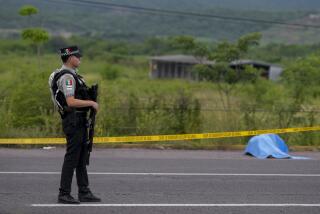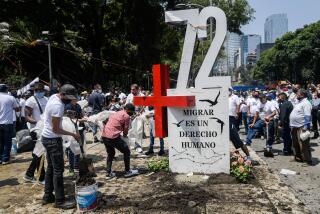El Salvador’s War Legacy: Teen Violence
- Share via
SAN MIGUEL, El Salvador — At 17, Gustavo Adolfo Morales is a legend--the hero of a rap song banned from the radio airwaves and the symbol of a lost generation.
He has been convicted of murdering six people in a two-year reign of terror as a youth gang leader in this sweltering city in eastern El Salvador. Police suspect that he actually killed 17 people in all, but proving his guilt in the other 11 crimes would be academic.
No matter how many people he killed, Morales will serve only seven years because he is under 18 and that is the maximum sentence for a minor, no matter how horrible--or numerous--the crimes.
The short sentence has raised an outcry in this tiny nation of 5.6 million people where a wave of postwar violence has reached stunning proportions: 2,192 people were slain in the final six months of last year alone. That compares with 426 killings in all of 1998 in Los Angeles, a city of 3.7 million.
Although no figures clearly show what proportion of slayings and other violent crimes are committed by minors, the perception among police, officers of the juvenile justice system and the public is that young offenders are a major part of the problem.
“These are the children of the war,” said Manuel Contreras, a psychologist for the juvenile courts. “The desensitization of the war had its effects in the most vulnerable group, which are the children.”
During the 12-year civil war that ended in 1992, many children were orphaned or abandoned. Some were spies or soldiers for the guerrillas or the army. Others, like Morales, grew up in an atmosphere of stress and violence, especially prevalent in cities such as San Miguel that were at the edge of war zones.
Now they are teenagers, and society is paying for the neglect.
Just how high that price is became evident this year when Morales was arrested. Based largely on testimony from members of rival gangs, police began finding bodies throughout the section of the city roamed by his gang, the Bunch of Crazy Southerners--a unit of the Mara Salvatrucha, a Salvadoran “megagang” with affiliates stretching from Los Angeles and the Bay Area to Central America--and connecting other unsolved killings to Morales.
The police soon acknowledged what the neighbors around the rundown Tesoro section of San Miguel had known for months: A gang war was claiming the lives of area youths.
“As long as gang members were killing each other, the police just ignored it,” said Juan Jose Villacorta, the equivalent of a public defender for young offenders. The police became interested only when the nephew of a prominent local official was killed, he said.
The investigation led police to Morales, a fatherless boy who had been a gang member since he was 12. The thin youngster’s arms, chest and legs are nearly covered with tattoos, but the most striking are the gothic M and S, for Mara Salvatrucha, above his eyes. He is known as “El Directo,” an expression that means roughly “beyond crazy” and often refers to crack cocaine users.
Speaking in a voice barely above a whisper, Morales denied in a jailhouse interview that he had committed any of the killings. “Other people did this,” he insisted.
Details of Killings Shock Country
Based mainly on the testimony of three witnesses--a taxi driver and two rival gang members--police originally accused him of 17 murders. The number as well as the brutality of the slayings shocked even Salvadorans, who usually seem inured to violence.
Morales was convicted of walking up to Enrique Sanchez on a corner in January 1998 and killing him with one pistol shot because he wanted to leave the gang. When Roberto Carlos Diaz objected to the murder two weeks later during a gang gathering at a deserted house, Morales beat him to death with a baseball bat, then dumped his body in a ditch, according to court records obtained by The Times.
Morales forced Sanchez’s girlfriend, Maria Candelaria Quinteros, to become his girlfriend, then in May 1998 lured her into a gathering of seven gang members at the house, where she was gang-raped, according to the records. Gang members then stuffed a red handkerchief in her mouth and strangled her with a rag, the court records said. Her body was thrown down a well, the documents stated.
Another young rape victim was hacked to death with a machete, according to court records. The killings continued throughout 1998, and police found evidence of others committed in 1997.
Unlike the law in many U.S. states, El Salvador’s criminal code makes no exceptions for minors who are suspected of committing heinous crimes. Morales would be tried as a juvenile.
Prosecutors decided that they could make a case in seven of the killings. Police had no blood, DNA samples or ballistics tests linking the victims to Morales--just the testimony of witnesses. Still, they got seven homicide convictions, although one was thrown out on appeal.
Ironically, laws meant to protect juvenile offenders keep the court documents secret, preventing the public from finding out how tenuous the evidence against Morales was.
So the young man became a media monster. The legend grew when he escaped from the juvenile detention center in San Francisco Gotera, near the Honduran border, in early May. He was caught three days later when he boarded a bus and tried to rob passengers, according to police.
A local rap group, Mecate, or Rope, released a song about his exploits that was a hit on local radio until an Interior Ministry official called the stations, reminding them of the government’s right to ban songs that offend public decency.
Now Morales is kept in a high-security area of the detention center, a converted army barracks. His cellmates are men, now adults, being detained for crimes they committed as juveniles.
“What they want to do is lock him up, not treat him,” said Claudia Carrion, a juvenile court psychologist.
Like Villacorta and other juvenile justice officers, she believes that Morales has been singled out as an example by Salvadorans who want to see changes in the progressive juvenile justice code that was enacted five years ago. That code states that minors will be rehabilitated, not punished.
Legislation to change the entire criminal code, including provisions related to juveniles, has been introduced to the National Assembly under pressure from citizens groups.
“The participation of minors in crime is quite significant,” said David Gutierrez, president of an anti-crime organization that has lobbied for tougher laws. “The criminal code favors them.”
Besides Morales, the San Francisco Gotera juvenile center houses violators like David Quintanilla and Ramon Rivera, who are clearly war victims.
Quintanilla, 18, has been imprisoned for more than two years because of convictions for kidnapping and extortion. Years ago, his parents abandoned him, seeking asylum in Los Angeles and leaving him with his grandmother, who died last year.
“I hated my mother,” he said. “I did not want to see her. I said that if she came back, I would kill her.”
But when his mother did return in January and visited him, he felt different.
“He changed completely,” said Judge Nohemi Reyes Najarro, who oversees his case. Quintanilla began to have his tattoos removed and take an interest in school. He attributes the change to a religious conversion two months ago, but Reyes Najarro is convinced that his mother’s visit made the difference.
Rivera, 23, has had no such watershed. But he gradually has come to realize how the war shaped his life. He joined the guerrillas at age 13 and stayed until he was mustered out at the end of the war seven years ago.
“They gave me $1,725 in demobilization pay, and I used part of the money to buy a gun,” he said. Along with friends he had met in the guerrillas, he began to rob and threaten people for money. He became a member of a gang.
“The war did not teach me good ideas,” Rivera said. “If I had not been in it, I would not have had the nerve to do what I did.”
More to Read
Sign up for Essential California
The most important California stories and recommendations in your inbox every morning.
You may occasionally receive promotional content from the Los Angeles Times.










